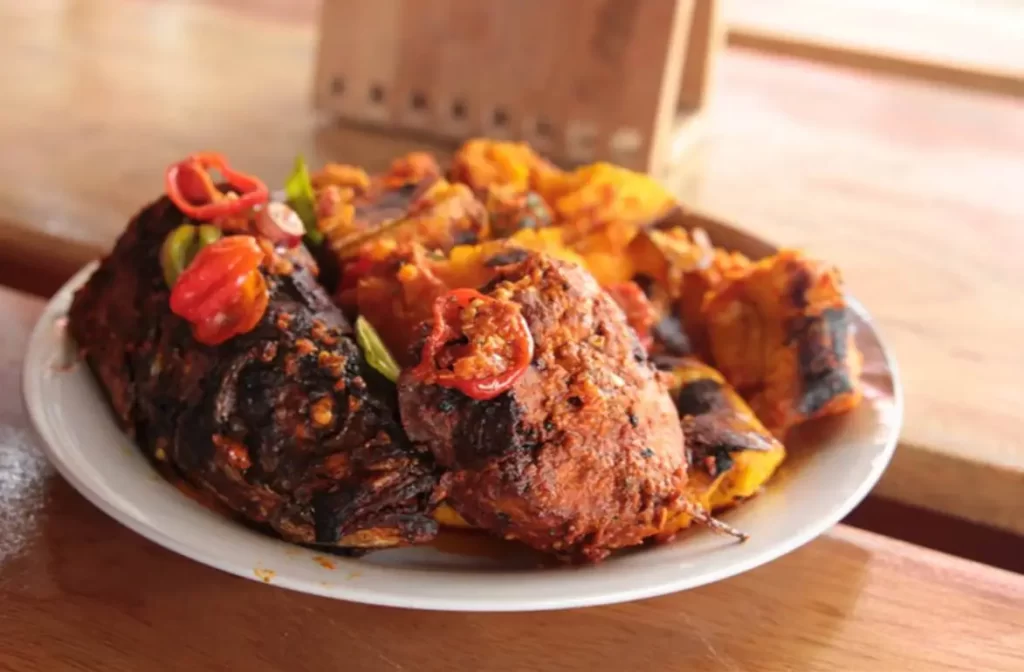10 Most Common Traditional Nigerian Foods
Nigerian dishes you cannot afford to miss not tasting at least once

Nigeria is fortunate to have a variety of tribes that have learned to coexist and adjust to one another. This adaptation has also extended to the eating of foods that come from other parts of the nation and can be relished at home or in the vicinity of these well-liked foods.
Every tribe has a wide variety of specialties, some of which are quite popular in the speaking areas, so there are far too many of these meals to list in one count. The only goal of this piece is to highlight a few of these mouthwatering dishes.
North
Suya
A tasty Nigerian meal from the country’s northern part is called suya.
It is a Hausa dish prepared by grilling chunks of skewered meat (often beef) with salt, onions, ground peanuts, pepper, and other seasonings. It tastes spicy and fleshy thanks to these spices. Local Hausa street vendors primarily sell it in different parts of cities.
These Vendors walk the streets of Nigeria at night to create suya, showing off their talents and serving their unique creations. At contemporary gatherings, suya is occasionally offered alongside small dishes like puff pastries, samosas, and sausage rolls.
Kilishi is another suya variant. Kilishi is a much thinner, tougher, and drier kind of suya, but both versions of the dried meat are excellent for a cold wine/chilled beverage night out.
Tuwo Shinkafa
A sort of Nigerian swallow meal called tuwo shikkafa is connected to the Hausa people of northern Nigeria. Although rice flour can also be used to make it, short-grain rice is the typical ingredient.
The rice is boiled until it has absorbed all of the water and is mushy and sticky. Before being served as a side dish to soups like miyan kuka and miyan kardashi that are quite typical to the region, it is then mashed into a soft dough, molded into the container it is introduced to, and rolled into balls.
South
Bole (Boli)
Even though South West of Nigeria is said to be the supposed home to the tasty street dish known as bole(boli), it is predominantly seen and consumed better in the country’s southern regions. It is typically eaten with peanuts or sauce, meat or fish, and is made with roasted plantains, either ripe or unripe.
Boli contains a lot of fiber, antioxidants, iron, potassium, protein, and vitamins A, B, and C, among other nutrients. As a typical delicacy that has crossed the shores of the Southwestern region to other parts of the country, especially Port-Harcourt, picking up some boli and some peanuts for a hearty, healthful supper is always a welcomed idea.
Consume bole cooked with ripe plantains for a sweeter flavor. A bole made from unripe plantains is a healthier option for individuals following a low-carb diet. The mouthwatering boli can also be served with the Sauce of choice, including peppered fish stew.
Afang Soup
This soup, which is a specialty of the Efik tribe, is also highly well-liked and is prepared with both okazi and water-leaf leaves. This soup is best enjoyed with dishes like eba, pounded yam, or fufu. It is made with Okazi and water leaves, palm oil, ata rodo (scotch bonnet/habanero pepper), and a variety of sea delicacies.
West
Amala
One of the dishes that will always be associated with the Yoruba people is Amala. This is a specialty that is popular in the southwestern region of Nigeria. Yam flour (àmàlà isu), cassava flour (àmàlà láfn), and plantain flour (àmàlà ogede) are the three types of àmàlà.
The peeled and dried Yam chunks are ground into a powder to create yam flour. It is either black or a dark brown color. The dried cassava is ground into a fine powder to make cassava flour, which has a light color.
Unripe plantains can also be peeled, dried, and mixed to make the plantain flour variation. In comparison to the other two variants, it has fewer carbohydrates. Those with diabetes and those following a low-carb diet favor this the most. Amala can be consumed with jute mallow soup(Ewedu) or any other soup of your choice.
Asaro
Another delectable yam dish popular in the southwest of Nigeria is Asaro. The yam is extremely important to the Yoruba.
Boiled yams, palm or vegetable oil, peppers, tomatoes, salt, stock cubes, and other ingredients are used to make Asaro. The ingredients are combined with a few mashed yams. Any time of day is appropriate for eating this meal. Usually, it has meat, poultry, crayfish, shrimp, or some combination of them. The popular accompaniments are fried or boiled plantains, tomato stew, efo riro (mixed spinach stew), and various sauces. In several places in Nigeria, one can order the dish’s hot liquid with yam chunks. Fiber, potassium, copper, carbohydrates, and vitamin C are particularly abundant in the meal as it has numerous proven health advantages.
Obe Ila Asepo
Another exceptional Cuisine is Okra mixed soup called “Obe Ila Asepo.” The first step in making it is to chop up some excellent okra, a green vegetable.
After being sliced, the okra is cooked with palm oil, peppers, tomatoes, onions, locust beans, and other ingredients and seasonings. Many fish, cow skin, meat, and occasionally ogbono (African mango) seeds are used to garnish the okra soup. Because both okra and ogbono are “draw soups,” adding them together makes the soup thicker and silkier. It is a favorite lunchtime dish in Nigeria. It complements hearty mainstays like Ebà, Pounded yam, and Fufu.
The product Obe Ila Alasepo is a good source of vitamins, fiber, folic acid, and other nutrients.
Gbegiri and Ewedu
One of the best Yoruba cuisines is Gbegiri. The black-eyed bean soup looks good and tastes even better when in the company of Ewedu. Ground black or brown beans, beef or chicken, fish, veggies, and seasonings are used to make it. Yam flour meal or crushed yam can be used to serve Gbegiri.
Among the ingredients for Gebegiri are Ground black-eyed or brown beans, smoked mackerel, stewed beef or chicken, ground crayfish, seasonings, Palm oil, freshly ground pepper, salt to taste, and vegetables (kale, spinach, etc.). Ewedu, on its part, comprises Ewedu leaves, crayfish, and distinctive seasonings. To get a flavor that will make your mouth water, add the Ewedu broom. Semo, Amala, or Eba go nicely with the Ewedu sauce, even though it’s a welcomed companion for Gbegiri. Cooking ewedu requires the necessary availability of components like the Jute leaves -frozen or fresh, Bean Crayfish Locust, Bouillon powders (cube), and Salt as desired.
Ewa Agoyin

This is typically beans and bread in a sumptuous combination. Ewa Agoyin is very popular amongst the Westerners especially in places like Lagos. The beans is cooked till it softens and a generous amount of Palm Oil is poured on it. The Sauce/Oil for the beans varies in preparation amongst homes but one component must remain constant; The generous amount of Oil.
East
Ogbono Soup
Blended ogbono (African mango) seeds are used to make ogbono soup. The Igbo people of Nigeria’s south-eastern region are the primary consumers of this soup, which is also popular in the southwest.
It is frequently prepared with stock, pork, fish, spices, and palm oil. It goes best with Ebà (cassava meal), àmàlà, or pounded yam for a delicious combo.
Ogbono is delicious and contains essential elements like fat, protein, iron, fiber, zinc, vitamins, potassium, and calcium. This Nigerian meal is loaded with health advantages.
Because of its duration and process of cooking, it is known to be a quick, simple, and adaptable dish. One can cook it with or without vegetables, okra, or egusi (melon seeds) according to preferences.
Abacha
The traditional Igbo dish Abacha, also known as African Salad, is said to have originated in Enugu and is a dish made from Cassava. Abacha can be served as an appetizer or the main course, but it is typically given to guests as a form of welcome before the main course. Depending on the neighborhood or home visited, there are numerous methods to prepare abacha, and fresh palm wine is the ideal accompaniment. Consumption of Abacha (and Okpa) is very common in Enugu and around the Eastern parts of the Country.
Okpa
Okpa, also known as “king’s meal” or “lion’s food,” is a well-known Igbo snack/delicacy from Eastern Nigeria that has said origins from Enugu. The grain (and powder) used to make okpa comes from the bambara nut. Okpa is very simple to make because it only needs a few components and cooks in 45 to 50 minutes. You can purchase okpa, which is typically covered in banana leaves or thin white nylon bags, almost anywhere in Enugu because vendors sell them in almost all of the restaurants and parks in the region. It is best to consume okpa with Tea, Pap, Coke, or soaked garri.
Ukwa
One of the most common meals consumed by Igbo people is ukwa. The ingredients are organic breadfruit. The seeds are shelled, cleaned, and cooked in water and crystal soda (akanwu) until they are tender enough to eat. Rice can also be prepared alongside Ukwa.































